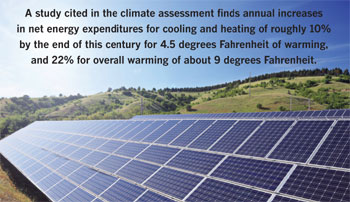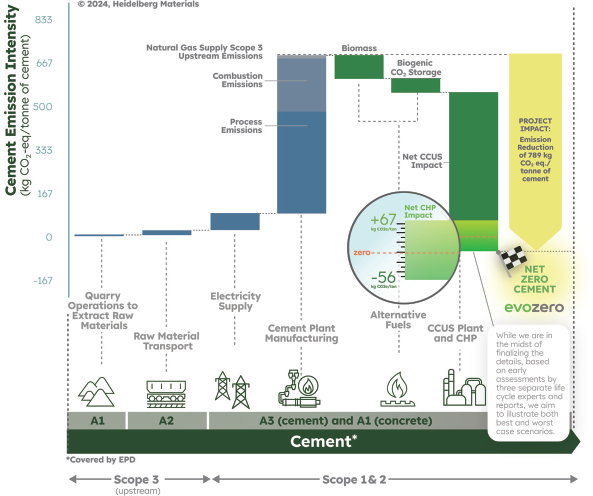July 2014
COMMUNITIES: INDUSTRY
The Climate Isn’t the Only Thing Changing in the US Energy Sector
 The latest National Climate Assessment released in May finds the US energy supply system is vulnerable to many of the projected impacts of climate change, but engineers in the industry are eager to meet the challenges of the current century.
The latest National Climate Assessment released in May finds the US energy supply system is vulnerable to many of the projected impacts of climate change, but engineers in the industry are eager to meet the challenges of the current century.
“This is the most exciting time to be in utilities because of all of these challenges going forward that are going to need to be met,” says American Public Power Association Senior Vice President of Engineering Mike Hyland, P.E. “We’re doing a lot more preparation of our systems, we are building a more robust, redundant, and resilient grid now.”
The new climate assessment is only the third such report completed since Congress mandated a research program into global change through the Global Change Research Act of 1990. It was developed over four years by top climate scientists and technical experts and guided by a federal advisory committee.
“The US energy supply system is diverse and robust in its ability to provide a secure supply of energy with only occasional interruptions,” the assessment finds. “However, projected impacts of climate change will increase energy use in the summer and pose additional risks to reliable energy supply. Extreme weather events and water shortages are already interrupting energy supply, and impacts are expected to increase in the future.”
While Hyland agrees with some of the projections of the assessment, he doesn’t think the US energy supply system will fail because the industry is changing and those working in it are up to the task.
“Everybody used to talk about reliability, reliability, reliability,” he says. “If you look at state legislatures and law firms and consultants and you look at what words they Googled over the last decade, back in 2002, 2003 reliability was the word most Googled. Now the word resiliency is Googled twice as much as reliability. So resiliency is becoming something that people are trying to get their arms around.”
“If a utility is not doing that, well, that utility is probably going to be nonexistent,” Hyland adds matter-of-factly. “You need to be steady and moving in this direction.”
As a result of climate change and how it changed the industry, engineering in the US energy sector has changed as well. “It’s become a sexier engineering than it used to be,” Hyland says. “It used to be you sit at a desk and you do calculations on how to do protective relaying on the lines.”
Now utilities engineers must deal with things like installing rooftop solar systems, designing for resiliency, designing for energy efficiency, smart meters, backhauling data, using data. Of course, not all of these and other changes are solely the result of climate change. Many changes, like the greater need for communications skills, are also the result of new and improving technologies.
“Communication has become more and more present,” Hyland says. “Social media—Facebook, Twitter accounts—every utility has one. Every utility has a communications presence, and these engineers are not kept from that. These engineers need to be able to speak on their feet and make presentations, they need to talk to consumer groups, [and] they need to talk to irate customers.”
Despite the impacts climate change is having on the industry and engineers, the impact on energy use in summer may be of little consequence. The industry not only has decades of experience planning for seasonal load increase, but it’s possible there may not be increases at all.
“If you look back to when many areas started to put in air conditioning, that was probably the most impactful time period, where we went from a society that didn’t have air conditioning in the ’50s to a society where everybody had air conditioning in the ’90s, and the load growth in the summer was astronomical,” Hyland says. “What happened was the utility industry—it’s run by a lot of forward thinking, diligent engineers—prepared for it. When we do our planning at utilities, we’re not looking out to next summer. That’s not how we plan. We’re doing five-year, 10-year, and 20-year case studies.”
A study cited in the climate assessment finds annual increases in net energy expenditures for cooling and heating of roughly 10% by the end of this century for 4.5 degrees Fahrenheit of warming, and 22% for overall warming of about 9 degrees Fahrenheit. In looking at their case studies and other data, however, some utilities have seen their loads flatten.
The primary reasons utilities are seeing flattened loads are less industry and more energy-efficient technology, Hyland says. “Unless industry comes back in great numbers, this country will not see an increase.”


 Volunteering at NSPE is a great opportunity to grow your professional network and connect with other leaders in the field.
Volunteering at NSPE is a great opportunity to grow your professional network and connect with other leaders in the field. The National Society of Professional Engineers (NSPE) encourages you to explore the resources to cast your vote on election day:
The National Society of Professional Engineers (NSPE) encourages you to explore the resources to cast your vote on election day:


